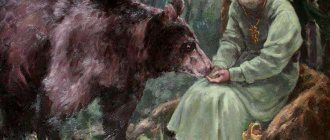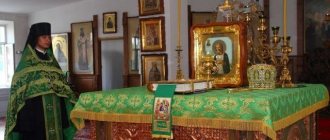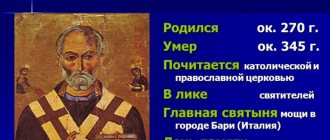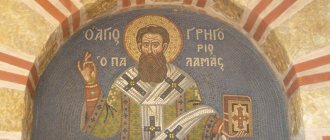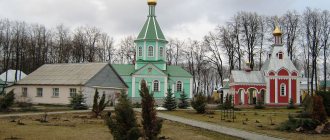Life of the Wonderworker Seraphim of Sarov
The life of St. Seraphim of Sarov has earned the national veneration and love of the Orthodox people: he is always close to our souls and invisibly remains with us in suffering, sorrow, and trials.
Therefore, you cannot find a temple in Russia where the face of Seraphim does not reside on the iconostasis.
Lives of other Orthodox saints:
- Life and biography of Alexander Nevsky
- Life and biography of Stefan of Perm
- Life of the Holy Venerable Kuksha of Odessa
Icon of Seraphim of Sarov
Infancy
The baby Prokhor came into the Light of God in 1754. His father served as a merchant and was involved in the construction of buildings. At the end of his life, he decided to build a cathedral, but did not live to see the completion of the construction. The boy remained with his mother, she raised him and instilled in the child a deep faith in Christ.
After the death of her husband, the widow continued the construction of the cathedral. One day she took Prokhor with her to a construction site. But he unexpectedly stumbled and fell from a high bell tower. The mother rushed down and found her child safe and sound. Thus, the Creator Himself preserved the life and health of His future lamp.
Prokhor had an excellent memory and science was easy for him. The teenager loved to attend services and read Lives and the Gospel to his friends. One day the boy became seriously ill, and doctors could not find a medicine to cure him. But in a dream vision, the Mother of God promised to cure a serious illness. Soon a religious procession with the “Sign” icon took place at the family estate.
The mother carried the sick man out and placed him on the Face of the Virgin Mary, after which the boy quickly recovered.
Beginning to Serve the Lord
From a young age, Prokhor dreamed of dedicating his life to the Savior and entering a monastery. The mother did not interfere with her son’s will and blessed him for monasticism with a crucifix. The saint wore this cross on his chest all his life.
Once Prokhor, as part of the pilgrims, went on foot from Kursk to Kyiv to worship the Pechersk saints. There he decided to flee to the Sarov desert. Returning to his father’s house, Prokhor said goodbye to his mother forever and went to Sarov. The abbot kindly received the God-loving young man and appointed him a confessor, under whose leadership the future saint performed his obediences.
The young man was a cell attendant, worked in a bakery, a prosphora bakery, worked as a carpenter, and was a sexton. He performed any type of work with special zeal.
A couple of years later, Prokhor fell ill with dropsy, his body became very swollen, he was in great pain and difficulty. He was looked after both by his mentor and by those monks who loved the kind and hardworking young man. The illness plagued his body for about three years, but none of those around him heard a drop of grumbling from Prokhor. The elders wanted to call a doctor to see him. But Prokhor strictly forbade them to do this; he wanted only one thing - a speedy Communion.
Then a vision happened: the Most Holy Mother of God appeared in the Divine Light and touched the patient’s side with a rod - immediately the liquid, which was in abundance in Prochorus’ body, began to flow out through the resulting hole. The young man quickly recovered.
Pavel Ryzhenko “Seraphim of Sarov”
tonsure
Prokhor lived as a novice in the monastery for 8 years, after which he was honored to accept monasticism. In his tonsure he was given the name Seraphim. A year later, observing the young monk’s fiery love for the Lord, the abbot decided to elevate Seraphim to the rank of hierodeacon.
The monk served in the temple every day, and after the service he prayed incessantly.
The zealous service of the monk was rewarded by the Almighty: Seraphim was granted visions of grace during the services. He repeatedly contemplated the heavenly Angels who co-served the monastery brethren.
And one day during the service, when the abbot pointed the orar at the prayer books, a golden ray overshadowed him. Seraphim looked up and saw the Savior Himself, He walked from the temple doors, accompanied by the Ethereal Heavenly Forces. The monk froze with admiration and delight; he could not even move from his place.
After the miraculous vision, Seraphim began to be more zealous about his service: during the day he worked as hard as he could in the monastery, and at night he left his native walls and went into the forest to pray.
Seraphim of Sarov: everyone has their own path
Author Yuri Nosovsky
14.01.2019 08:00
Religion » Religions of Russia » Orthodoxy
On January 14, 1833, in the Sarov monastery in the Tambov region, Hieromonk Seraphim (Moshnin) reposed in the Lord. He became the last saint canonized before the revolution of the 17th year. Holiness of St. Seraphim of Sarov illuminated those around him even during his earthly life, thanks to which he became the most famous ascetic of the Russian Land of the 19th century.
The future great saint was born in 1759 in Kursk, into a merchant family. From early childhood he was surrounded by real miracles caused by the deep intercession of the Mother of God. So, at the age of 7, a boy, unable to hold on to the handrail, fell from a high bell tower, but did not suffer any harm from the fall. At the age of 10, he became seriously ill, but was healed almost instantly when the Kursk-Root Icon of the Mother of God, taken out of the church during a religious procession, was applied to him.
At the age of 18, having received a blessing from the perspicacious Kyiv elder Dositheus (in fact, the maiden Daria Tyapkina, who hid from the world in men's clothing, following the example of ancient ascetics, until her death), he entered the Sarov monastery as a novice. There he soon fell seriously ill again - his whole body was a complete swelling. But 3 years later, after visiting the Virgin Mary in a dream vision, the illness passed without a trace. The last time the ascetic was healed by the Mother of God was already in old age, after he was beaten half to death by robbers - and the invited doctors admitted their powerlessness. In general, the Mother of God appeared to the saint 12 times during his life—perhaps more often than all other Russian ascetics.
The life of the Sarov monk was in many ways similar to the exploits of the latter. He lived alone in the desert for a long time, did not eat bread for years, eating collected grass, to him, as to St. Sergius of Radonezh, wild animals, including a bear, came without fear. St. Seraphim was subjected to severe devilish temptations, but he fought against them only by strengthening his already heroic life. So, one day he prayed on a stone for 1000 days and nights, almost without a break, until his legs began to swell and become covered with ulcers. The saint’s miracles cannot be counted—healing the sick, the demon-possessed, helping with everyday needs—during his life and after death.
Feat of desert living
At the age of 39, the monk was elevated to the rank of hieromonk and was blessed to conduct the Divine Liturgy. When the abbot of the monastery departed to the Lord, Seraphim took upon himself the feat of living in the desert (the late Father Pachomius blessed the monk before his death). Having received another blessing from the new abbot, he retired into the deep forest.
But he did not completely abandon the monastery; every Saturday evening, before the start of the all-night vigil, he returned to the monastery and received the Holy Mysteries of Christ.
The exploits of Seraphim, which he performed in the Name of Christ, were severe:
- his prayer rule was carried out according to the Rule of the ancient desert dwellers;
- he constantly studied the Holy Gospel, the New Testament, diligently studied liturgical literature;
- the monk knew many chants by heart, and when he worked in the forest, he loved to hum them;
- he got food for himself, worked in the garden;
- He kept a strict fast, ate only once a day, and went hungry on fasting days of the week.
His meager diet during the first three years of hermitage consisted of herbs. Occasionally he was visited by the same hermits.
The rumor about the solitary life of the priest spread beyond the monastery and monks and laymen began to visit him often. Each person needed wise advice, answers to questions and blessings for their work. Soon Seraphim forbade women from visiting his cell, and then everyone else, because in another vision the monk saw that the Lord desired the monk’s complete silence.
The saint’s social circle narrowed; now only wild animals and birds could visit him. Seraphim loved to feed wild bears with bread, which was delivered to him from the monastery bakery.
Icon of Seraphim of Sarov
Temptations of the devil
The monk's lofty exploits aroused the disapproval of the devil. He decided to frighten the saint so that he would remain silent. The monk did not succumb to the attacks of dark forces, but Satan stubbornly continued the temptation. But Seraphim, in order to repel the onslaught of the enemy, took on the feat of pillar-bearing for 1000 days.
But disgraced by the saint’s faith, the devil decided to kill the saint and sent robbers to him, who began to demand money from him. Naturally, he had no money, for which the robbers brutally beat the monk and broke his head with an ax. The saint lay in a lifeless state until the morning, and when he woke up, with the last of his strength he made his way to the monastery. The brethren were horrified by the sight of the wounded ascetic. For eight days, the monastery doctors pulled Seraphim “from the other world,” because the wounds he received were incompatible with life.
But the healing did not come from doctors. The Queen of Heaven appeared to him in a dream and, touching his wounded forehead, gave him health. But the monk’s back remained hunched, so he had to walk leaning on his staff.
The monk spent about six months in the monastery, and having gained strength, he returned to his forest cell. He spent three years in silence. Seraphim was asked by the abbot and the brethren of the monastery: to attend services and receive communion, or to return to the monastery. Seraphim chose the second because, due to his injury and advanced years, it was difficult for him to walk from the forest, in which he accomplished the feat of living in the desert for 15 years, to the monastery.
The end of the earthly journey
Returning, he added a shutter to the feat of silence. The monk did not leave his cell and did not receive anyone.
For his labors, he was honored by the Lord with the gift of working miracles and was assigned to serve people in the feat of old age. The Mother of God herself appeared in a dream to Seraphim and commanded him to come out of seclusion in order to receive petitioners asking for guidance, consolation, and healing.
Now the door of the elder’s cell was open to everyone! The miracle worker contemplated human hearts, healed parishioners with prayer, and consoled them with kind words.
In the last years of his life, Seraphim took special care of the Diveyevo monastery, which was his brainchild. He was a kind father to the sisters of the monastery, looked after the monastery, and the sisters turned to the elder in all difficulties.
A year before his death, Father Seraphim became very weak and made a coffin for himself. He showed the monks the place where his body should be buried. On January 1, 1833, the elder took communion for the last time, after which he blessed the brethren and gave good wishes to each monk, and the next day he reposed in the Lord.
His body was found lifeless before the Face of the Mother of God.
During illness in adolescence
Cross in pocket
Serafima Voskresenskaya is a pupil of an orphanage who lost her family during the Great Patriotic War. All that remains for her from her relatives is a pectoral cross, which she carefully keeps in her pocket. One day, Sima and her friend Rita go to a closet under the stairs: they say ghosts live there. From this moment on, the girls find themselves in a whirlpool of events - they learn the history of the orphanage and the cleaning lady Aunt Lisa, who was the mistress of this once luxurious mansion. But Sima’s most sincere desire is to find her parents, and thanks to a miraculous meeting with St. Seraphim of Sarov, it comes true.
The plot is based on the book of the same name by writer Timofey Veronin. Moreover, initially the creators did not even think about the cartoon format - they wanted to make a film about the saint. However, after going through many options, we finally settled on a story without parables and moralizing. To make the picture authentic, the film crew visited Diveevo, where the revered miracle worker lived.
Legends of Russian cinema gave their voices to the animation characters
— Our cartoon is different from others - it’s a drama. There is room here for both historical and religious themes; psychological aspects are touched upon,” says composer Ivan Uryupin.
The artist Yuri Pronin was responsible for the depiction of the cartoon characters. The hardest thing was with Seraphim - the sketches were very different, but they were looking for a recognizable and accurate image of the saint for two years. It turned out completely differently with the main character: the girl turned out flawlessly almost from the first drawing. Of course, there was a small miracle. There is a scene in the cartoon when Seraphima enters a church and sees a small cell right inside it. Here the girl meets the old man. Later, the creators learn that this is exactly what the temple in Sarov looks like: it was built over the monastery hut, where the elder lived and prayed. The authors emphasize that “The Extraordinary Adventures of Seraphim” is designed for the widest audience.
— It is important that we did not make a cartoon for believers, we made a cartoon for people. “I think the film will be interesting to everyone, because talking about love is a universal and immortal topic,” says director Stanislav Podivilov.
By the way, legends of Russian cinema gave their voices to the heroes of history. Seraphim of Sarovsky is voiced by People's Artist of the Russian Federation Alexander Mikhailov, and Aunt Lisa is voiced by People's Artist of the USSR Vera Vasilyeva. In the near future, the film will be translated into English so that other countries can see it.
Holy relics
70 years after the death of the God-bearing elder, people came to his grave for consolation in sorrows, help and healing from illnesses. The saint had not yet been canonized, but thrones were already being prepared in his honor, a life and prayers were being compiled, and icons were being painted. And only in 1903, Elder Hieromonk Seraphim was canonized.
On his birthday (July 19), the discovery of his honest relics took place. After the revolution they disappeared.
Their second discovery took place only in 1991 in St. Petersburg, after which they were taken in a religious procession to the Trinity Seraphim-Diveevsky Monastery.
Miracles
Many miracles are associated with the name of the great elder. Through prayers to Blessed Seraphim, the dumb found their voices, the blind saw their eyes, the crippled were freed from lameness, and the paralyzed could move their limbs.
- The 19-year-old girl had cramped limbs, her hands were tightly clenched on her chest. After visiting the grave of Seraphim and bathing in the spring consecrated in the name of the God-bearer, the patient stood up independently, her arms and legs straightened, and she began to move independently.
- The peasant woman was paralyzed 6 years ago. She, immobilized, was brought to the spring and dipped in it three times. The woman was completely healed.
- A mother and her deaf-mute daughter took part in the procession. At the front of the procession, banner bearers carried the Face of the Virgin Mary and a large icon of Seraphim of Sarov. The woman placed the child next to the image of the saint and the baby immediately called out to her mother in her voice.
- At the grave of the miracle worker, a young woman who had completely lost her sight several years ago regained her sight.
There are cases where people were healed from insanity, paralysis, oncology and other serious illnesses. All facts of healings are recorded in the Chronicle of the monastery.
